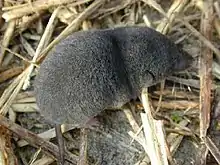Soricomorpha
Soricomorpha (from Greek "shrew-form") is a formerly used taxon within the class of mammals. In the past it formed a significant group within the former order Insectivora. However, Insectivora was shown to be polyphyletic and various new orders were split off from it, including Afrosoricida (tenrecs, golden moles, otter shrews), Macroscelidea (elephant shrews), and Erinaceomorpha (hedgehogs and gymnures), with the four remaining extant and recent families of Soricomorpha shown here then being treated as a separate order. Insectivora was left empty and disbanded.[1]
| Soricomorpha[1] Temporal range: | |
|---|---|
 | |
| Southern short-tailed shrew | |
| Scientific classification | |
| Domain: | Eukaryota |
| Kingdom: | Animalia |
| Phylum: | Chordata |
| Class: | Mammalia |
| Order: | Lipotyphla |
| Suborder: | Soricomorpha Gregory 1910[2] |
| Families | |
| |
Subsequently, Soricomorpha itself was shown to be paraphyletic, because Soricidae shared a more recent common ancestor with Erinaceidae than with other soricomorphs.[3] The combination of Soricomorpha and Erinaceidae, referred to as order Eulipotyphla, has been shown to be monophyletic.[4]
Living members of the group range in size from the Etruscan shrew, at about 3.5 cm and 2 grams, to the Cuban solenodon, at about 32 cm and 1 kg.
- Soricomorpha
- Family Soricidae (shrews)
- Subfamily Crocidurinae: (white-toothed shrews)
- Subfamily Soricinae: (red-toothed shrews)
- Subfamily Myosoricinae: (African white-toothed shrews)
- Family Talpidae: (moles and close relatives)
- Subfamily Scalopinae (New World moles and close relatives)
- Subfamily Talpinae (Old World moles and close relatives)
- Subfamily Uropsilinae (Chinese shrew-like moles)
- Family Solenodontidae: solenodons (rare primitive eulipotyphlans of the Caribbean; two extant species)
- Family † Nesophontidae: West Indian shrews (recently extinct eulipotyphlans of the Caribbean)
- Family † Heterosoricidae
- Family † Nyctitheriidae
- Family Soricidae (shrews)
References
- Hutterer, R. (2005). "Order Soricomorpha". In Wilson, D.E.; Reeder, D.M. (eds.). Mammal Species of the World: A Taxonomic and Geographic Reference (3rd ed.). Johns Hopkins University Press. pp. 220–311. ISBN 978-0-8018-8221-0. OCLC 62265494.
- Gregory, W. K. 1910. The orders of mammals. Bull. Am. Mus. Nat. Hist.27:1–524. https://books.google.com/books?id=z0IZAAAAYAAJ&q=Soricomorpha&pg=PA465
- A. L. Roca; G. K. Bar-Gal; E. Eizirik; K. M. Helgen; R. Maria; M. S. Springer; S. J. O'Brien & W. J. Murphy (2004). "Mesozoic origin for West Indian insectivores". Nature. 429 (6992): 649–651. Bibcode:2004Natur.429..649R. doi:10.1038/nature02597. PMID 15190349. S2CID 915633.
- Robin M. D. Beck; Olaf R. P. Bininda-Emonds; Marcel Cardillo; Fu-Guo Robert Liu & Andy Purvis (2006). "A higher level MRP supertree of placental mammals". BMC Evolutionary Biology. 6: 93. doi:10.1186/1471-2148-6-93. PMC 1654192. PMID 17101039.